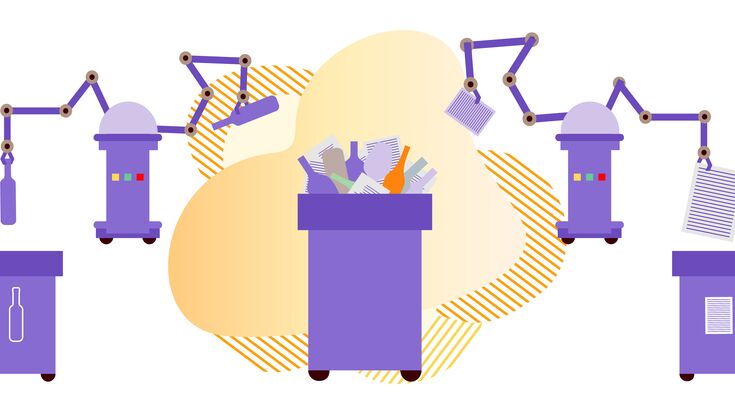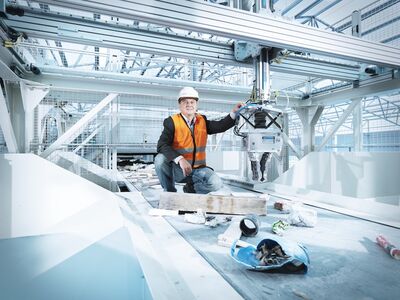Artifical Intelligence : Rise of the Machines: Robot Recycling

Robots have overrun the planet. Humans are battling with automated machines for jobs. Artificial Intelligence (AI) is present in everyone's homes. This may sound more like the plot for the latest Hollywood science fiction blockbuster than actual reality but you'll be surprised.
Ever since the industrial revolution machines and automated processes have dominated manufacturing processes. Take the automotive manufacturing industry. Assembly lines comprise robots repeating movements mindlessly but with sub-millimeter precision. Cars are produced in their millions and shipped worldwide to ever-demanding consumers. One industry that perhaps has not implemented as many automated solutions as others is that of waste management. Given its unpredictable nature (you can never predict just what is going to be disposed of) the sector lends itself to a highly skilled workforce. From employees 'on the front line' collecting recyclables on the street to experts in the control rooms of waste to energy plants monitoring emissions; the industry has provided a variety of jobs for decades. But could this be about to change?
C&D waste challenge
Municipal waste to one side, it is construction and demolition (C&D) waste where the next advancement in automated sorting is taking place. And let's face it - there's enough of it. Estimates from Eurostat suggest that in 2006 alone, there was 870 million tonnes of C&D waste generated in the EU alone. Making up 25% of all waste generated in the region, clearly solutions are needed for the mountains of concrete, metals, glass, wood and asbestos generated each and every year. This material is either sorted in large mechanised processing plants or manually by people.
While the EU frowns on the latter, many people are employed in manual sorting, picking raw materials off of conveyors. And it is this manual process Finnish start-up ZenRobotics is trying to change. Started in 2007, the firm's small team has more PhDs than most companies' board members put together. It was the erratic nature of waste handling that first attracted ZenRobotics.

"Succeed with waste, and you can do whole lot more," says Rainer Rehn, chief commercial officer at ZenRobotics. "Today robots are widely used in other industries with more structured environments, but our scientists viewed waste handling as the real test. We have previously served other industries, e.g. nuclear power and waste incineration plants. Now we are focusing on C&D waste. The impact of robotic sorting is initially greatest here."
Trial with SITA Finland
But do not be quick to judge or dismiss the operation as a group of young, crazy scientists playing about robots in a laboratory. Testament to how serious the firm is being taken, it has signed up with SITA Finland, part of European environmental behemoth Suez Environnement, for a trial involving a robotic arm sorting C&D waste with strict targets set.
Furthermore, a total of 16 companies were in the running for this trial - a clear sign of the appetite for automated solutions. This followed the technology being trialed in the firm's own facility for two years. So, the questions I know you are all thinking are 'how does this process work?' and 'how does it differ from other sorting techniques?'.
Intelligent design?
A combination of NIR cameras and 3D laser scanners are brought together by the company's AI Unlike robots used for automotive assembly, which repeat the same precise movement over and over again, the ZenRobotics process applies "sensor fusion and AI technologies".
In other words, the robots literally think for themselves. The firm says that "robot gripper" sometimes collides with objects, so it is equipped with pain sensors and a pain-avoidance reflex. But before I quiz Rehn over the serious stuff - such as operation efficiencies and the technology - I have to stop my imagination running away and ask the question whether ZenRobotics is ever concerned that its robots are so intelligent they become bored with sorting waste and decide to run away! "Over the years we've speculated about this scenario extensively over beers!" he retorts, before adding: "For now, however, our robots are happily sorting waste."
The Brain
So how does it work? A two-meter wide conveyor belt feeds the waste past a package of sensors including visible spectrum cameras, NIR spectroscopic cameras, 3D laser scanners and metal sensors. It's important to note here that the actual robotic arm is supplied through a German company. And the NIR detection and analysis system is supplied by another manufacturer. All of this information is then condensed and fed to the ZenRobotics artificial intelligence (AI). This is known as "the brain" of the operation, which brings everything together and is the Finnish company's patented work. Scanned objects are then analysed and following identification, the robotic arm picks up objects and deposits them into the correct containers. So far, three fractions - inert materials, wood and metals - are being identified for recycling.
"Successful sorting is quite possible but not by itself - the waste needs to be pre-processed. It needs to be crushed and material that is too small needs to be separated," SITA Finland CEO Jorma Kangas tells WMW. "Also, two dimensional material, such as cardboard and plastics, must be separated out first. For the trial we have separated out three dimensional items which are then sorted out further by the robots."
The CEO says the trial results will decide whether SITA Finland rolls out robots across the rest of its C&D sorting operations. Targets have been set up for the pilot and will be reviewed at the end of the year.
Commercial pay-back and practical reality
It is the phrase "commercial pay back" that is key here. Can facility managers really justify the initial investment into such an advanced system when they can instead rely on a team of workers paid a reduced salary? Yes, is the short answer from ZenRobotics. "With the components we are currently using, the system replaces around 10-15 human pickers," states Rehn enthusiastically. "The robots work day and night, they don't have lunch breaks, they don't have coffee breaks, they don't go out for cigarettes, they don't go home for sleep. If you look at picking speed, it depends on the human and the situation, but a typical picking cycle is between seven and 12 seconds for humans, whereas robots do the same easily in seconds."
And it is over the course of a year that the chief commercial officer believes facilities will notice a difference. "You need seven-hour shifts to run facilities," he says. "Waste workers work efficiently around 1600 hours per year. By the time you have taken off time for lunch breaks, getting changed and account for any time lost, you are close to 1000 hours. By the same measure, a robotic system, however, can work for 8000 hours per year."
The all important word here is "payback" - the period it takes for companies to recoup their investment. Rehn says it depends on the facility, but generally speaking, ZenRobotics calculates the payback to be less than two years. Cases are cited where this has been less than one year. ZenRobotic's confidence and vision can't be knocked. And with the firm boasting eight PhD caliber workers, it's easy to be drawn into their belief that this could soon be a reality. You only have to watch the company's corporate, albeit tongue-in-cheek produced video to get a feel for their international ambition. Looking into his crystal ball, Rehn predicts that ten years from now, C&D waste processing will comprise "five to 10 robots working in fully automated plants without humans involved, in a 24/7 operation".
Read more about data-driven sorting in our interview with Recycleye here!
We calculate that the payback be less than two years.Rainer Rehn, Zenrobotics
Industry reaction & MSW challenges
"Even the most automated MRFs (material recycling facilities) utilise real people for quality checks, and for dealing with one of the biggest problems in a MRF: when materials overlay one another and can be hidden from the laser eye," says Adam Read, global practice director for AEA Resource Efficiency. "And with unemployment figures running high around the world we may not want to embrace technology as much as we once did." On a positive note, Read says: "Necessity is the mother of invention, and if additional throughput is required to be processed at these sites, or if 24-7 processing becomes the norm, then perhaps the introduction of even more advanced technology could have a role to play."
If the system can prove successful in sorting C&D waste, then the question has to be asked about whether other materials - bottles, cans and paper - from the municipal stream could also be targeted? And, if so, what does this mean for the increasing use of NIR equipment - could robots indeed be a threat to such tried and tested solutions already operating globally? It appears not. "In the future we see robots and NIR systems working in a symbiotic relationship," says Jonathan Clark, country manager, UK, TITECH Visionsort. "Robots are clearly not able to pick at the rate of air-jets, for bottles and cans, so this stream will continue to be processed by optical sorting equipment using the standard air ejection system."
Interestingly, Clark refers to a previous unsuccessful trial using robot sorting technology but for municipal solid waste. "We must remember that this type of technology has been trialed before," he explains. "The Dutch company Bollegraaf ran trials in Holland a couple of years ago. This was a large-scale pilot to sort the conventional mixed waste stream. Unfortunately, it didn't work. The high number of very variable items on the belt such as paper, or bottles presented too great a challenge." While Bollegraaf was unavailable to comment, others agreed that MSW just wouldn't be feasible. "We are a long way off using this type of technology in a MRF handling MSW or C&I [commercial & industrial] recyclables â the mixed materials are too diverse and the belts are moving too quickly to really make this viable, plus existing technology allows for 95% efficiency and beyond, so why take this investment for little additional return?" adds AEA's Read.
Interesting topic? Read our interview with TOMRA about the evolution of recycling technology here!
Robot revolution: the future
Clearly, the trials in Finland will be an interesting addition to the scientific debate currently underway in the industry. Final package costs of the robots, software and the "Brain" will be a key factor. With ZenRobotics planning to start "shipping globally in 2012", clearly they are confident the trial results will be positive. Robotic arms may not have been successful for the sorting of MSW in the past. Construction waste, however, could be the low-hanging fruit they need to robotically pick their way into the lucrative waste business. Trial results are expected at the end of 2012, which the industry is eagerly awaiting. Whatever the verdict, the Finnish firm has to be applauded for channeling its PhD expertise into this industry. Watch this space: robots could be involved in more than just making your car very soon.


